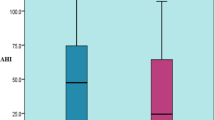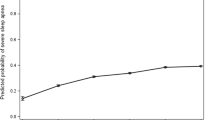Abstract
Purpose
The purpose of this study is to investigate the risk factors for obstructive sleep apnea (OSA) in young patients from an urban European city with many migrants.
Methods
The medical data of 2,343 patients referred for polysomnography from January 2007 till September 2009 were retrospectively reviewed in order to identify patients younger than 40 years with OSA and assess their characteristics.
Results
One hundred twenty-one of the 2,093 patients (6%) referred for diagnostic polysomnography were younger than 40 years and had OSA. There were 17 women and 104 men. The race was Caucasian in 55% (67/121) and African in 42% (51/121). The median apnea–hypopnea index (AHI) was 39 in men and 23 in women (p < 0.01), 30 in Caucasians and 39 in Africans (p = 0.03). BMI was positively correlated to the AHI (correlation of 0.19, p = 0.04). Multiple regression modeling showed that African origin (p = 0.01), current smoking (p = 0.05), and neck circumference (p < 0.01) were predictors of AHI, independently of BMI, but not the presence of upper airway abnormalities (p = 0.75). Co-morbidities were frequent (hypertension, 20%; diabetes, 13%; hypercholesterolemia, 27%; depression, 13%; reflux and gastric ulcer, 13%; hypothyroidism, 5%; asthma, 9%), and were related to BMI (p = 0.02), nocturnal desaturation time (p = 0.02), and African origin (p = 0.024).
Conclusions
In patients aged <40 years and suffering from OSA, disease severity was associated with high BMI, large neck circumference, male sex, and African origin. After adjustment for BMI, African origin, tobacco use, and neck circumference remained predictors of high AHI. Neither upper airway abnormalities nor co-morbidities were found to be a risk factor for higher AHI in this group of young patients from a European city.


Similar content being viewed by others
References
Young T, Palta M, Dempsey J, Skatrud J, Weber S, Badr S (1993) The occurrence of sleep-disordered breathing among middle-aged adults. N Engl J Med 328:1230
Riha RL, McNicholas WT (2009) The genetic and cardiovascular aspects of obstructive sleep apnoea/hypopnea syndrome. Eur Respir J 33:233–236
Marin JM, Carrizo SJ, Vicente E, Agusti AG (2005) Long-term cardiovascular outcomes in men with obstructive sleep apnoea-hypopnoea with or without treatment with continuous positive airway pressure: an observational study. Lancet 365:1046–1053
Findley LJ, Unverzagt ME, Suratt PM (1988) Automobile accidents involving patients with obstructive sleep apnea. Am Rev Respir Dis 138:337–340
Hung J, Whitford EG, Parsons RW, Hillman DR (1990) Association of sleep apnoea with myocardial infarction in men. Lancet 336:261–264
Dyken ME, Somers VK, Yamada T, Ren ZY, Zimmerman MB (1996) Investigating the relationship between stroke and obstructive sleep apnea. Stroke 27:401–407
Arzt M, Kral M, Sebah D et al (2009) Prognostic impact of sleep apnea an dits treatment in patients with chronic heart failure: 6-year follow-up from a sleep clinic sample. Am J Respir Crit Care Med 179:A5342
Mehra R, Stone KL, Varvory PD, Hoffman AR, Marcus GM, Blackwell T, Ibrahim OA, Salem R, Redline S (2009) Nocturnal arrhythmias across a spectrum of obstructive and central sleep-disordered breathing in older men: outcomes of sleep disorders in older men (MrOS sleep) study. Arch Int Med 169:1147–1155
Quintana-Gellego E, Carmona-Bernal C, Capote F, Sanchez-Armengol A, Botebol-Benhamou G, Polo-Padollo J, Castillo-Gomez J (2004) Gender differences in Obstructive sleep apnea syndrome: a clinical study of 1166 patients. Respir Med 98:984–989
Morrish E, Shneerson JM, Smith IE (2008) Why does gender influence survival in obstructive sleep apnea? Respir Med 102:1261–1266
Nieto FJ, Young TB, Lind BK, Shahar E, Samet JM, Redline S, D’Agostino RB, Newman AB, Lebowitz MD, Pickering TG (2000) Association of sleep-disordered breathing, sleep apnea and hypertension in a large community-based study. JAMA 283:1829–1833
Phillips BA, Berry DTR, Lipke-Molke T (1996) Sleep-disordered breathing in healthy aged persons: fifth and final follow up. Chest 110:654–658
Bixler EO, Vgontzas AN, Ten Have T, Tyson K, Kales A (1998) Effects of age on sleep apnea in men: I. Prevalence and severity. Am J Crit Care Med 157:144–148
He J, Kryger MH, Zorick FJ, Conway W, Roth T (1988) Mortality and apnea index in obstructive sleep apnea. Chest 94:9–14
Lavie P, Lavie L, Herer P (2005) All-cause mortality in males with sleep apnoea syndrome: declining mortality rates with ages. Eur Respir J 25:514–520
Redline S, Tishler PV, Hans MG, Tosteson TD, Strohl KP, Spry K (1995) Racial differences in sleep-disordered breathing in Afro-Americans and Caucasians. Am J Crit Care Med 155:186–192
Lee W, Nagubadi S, Kryger MH, Mokhlesi B (2008) Epidemiology of obstructive sleep apnea: a population-based perspective. Expert Rev Respir Med 2:349–364
Rechtschaffen A, Kales A (1968) A manual of standardised terminology, techniques and scoring for sleep stages in human subjects. Brain information Service, Los Angeles
www.inami.fgov.be Accessed 08 June 2010
Bonnet M, Carley D, Carskadon M et al (1992) EEG arousals: scoring rules and examples: a preliminary report from the sleep disorders atlas task force of the American Sleep Disorders Association. Sleep 15:173–184
Johns MW (1991) A new method for measuring daytime sleepiness: the Epworth sleepiness score. Sleep 14:540–545
Tishler PV, Larkin EK, Schluchter MD, Redline S (2003) Incidence of sleep-disordered breathing and sleep apnea in an urban adult population: the relative importance of risk factors in the development of sleep-disordered breathing. JAMA 289:2230–2237
Young T, Shahar E, Nieto FJ et al (2002) Predictors of sleep-disordered breathing in community-dwelling adults: the Sleep Heart Health Study. Arch Int Med 162:893–900
Young T, Skatrud J, Peppard PE (2004) Risk factors for obstructive sleep apnea in adults. JAMA 291:2013–2016
Ancoli-Israel S, Klauber MR, Stepnowsky C, Estline E, Chinn A, Fell R (1995) Sleep-disordered breathing in Afro-American elderly. Am J Crit Care Med 152:1946–1949
O’Connor GT, Lind BK, Lee ET et al (2003) Variation in symptoms of sleep-disordered breathing with race and ethnicity: the Sleep Heart Health Study. Sleep 1:74–79
Sharma SK, Kumpawat S, Banga A, Goel A (2006) Prevalence and risk factors of obstructive sleep apnea syndrome in a population of Delhi, India. Chest 130:149–156
Joo MJ, Herdegen JJ (2007) Sleep apnea in an urban public hospital: assessment of severity and treatment adherence. J Clin Sleep Med 3:285–288
Young T, Peppard PE, Gottlieb DJ (2002) Epidemiology of obstructive sleep apnea. Am J Crit Care Med 165:1217–1239
Wetter DW, Young TB, Bidwell TR, Badr MS, Palta M (1994) Smoking as a risk factor for sleep-disordered breathing. Arch Int Med 154:2219–2224
Young T, Finn L, Austin D, Peterson A (2003) Menopausal status and sleep-disordered breathing in the Wisconsin Sleep Cohort Study. Am J Respir Crit Care Med 167:1181–1185
Conflict of interest
All the authors have disclosed any form of conflict of interest.
Author information
Authors and Affiliations
Corresponding author
Rights and permissions
About this article
Cite this article
Bruyneel, M., Ameye, L. & Ninane, V. Sleep apnea syndrome in a young cosmopolite urban adult population: risk factors for disease severity. Sleep Breath 15, 543–548 (2011). https://doi.org/10.1007/s11325-010-0398-4
Received:
Revised:
Accepted:
Published:
Issue Date:
DOI: https://doi.org/10.1007/s11325-010-0398-4




